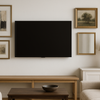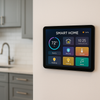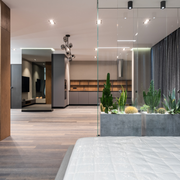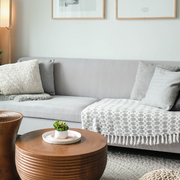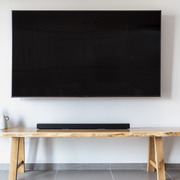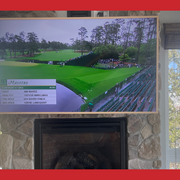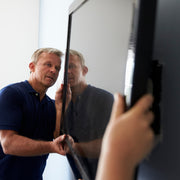Find the Perfect TV Mounting Height to Avoid Neck Strain

Find the Perfect TV Mounting Height to Avoid Neck Strain
What’s the best height to mount a TV? This article explains how to calculate the ideal height for your wall-mounted TV and choose a mount that keeps you comfortable.
Step 1: Measure
Begin by measuring the height of your eyes when seated on your sofa or chair. The midpoint of the screen should be at or slightly below this height.
For example: If your eye-level is 44 inches from the floor, and you have a 50‑inch TV (with a vertical screen height of about 24 inches), mount the TV so the center sits around 44 inches.
🤔 MantelMount Pro Tip:
When mounting above a fireplace or in a bedroom, where you watch from a reclined position, you may need to mount the TV higher but tilt it downward using a tilt or full‑motion mount to maintain a comfortable viewing angle.
>> Read More: Mounting Your TV on Brick or Stone
Screen size and viewing distance
Larger screens appear lower when viewed from farther away, so you may not need to mount them as high. Conversely, a small TV in a narrow room may need to be slightly higher to stay in your line of sight. To simplify planning, use a mounting height calculator that factors in screen size, viewing distance and seat height.
Viewing distance is just as important as height when it comes to comfort. Follow this simple formula to estimate the best viewing distance:
>> Measure the diagonal size of your TV and multiply by 1.5 to 2.5.
For example, a 50-inch screen is best viewed from about 6 to 10 feet.
Different mount types
A fixed mount holds the TV flush against the wall, which is ideal when the screen sits at perfect eye-level. A tilting mount lets you angle the screen downward if you must mount it higher, such as above a fireplace. Then there are full-motion mounts. A note about those:
💡 Before You Buy, You Should Know
Traditional full-motion mounts only provide outward movement from the wall, horizontal swivel articulation left and right, and in most cases, tilt. They do not move vertically. If you want a TV mount that also travels vertically, try the MantelMount MAX1. This mount features our maximum range of motion in all directions and flushest TV-to-wall appearance.
>> Compare MantelMounts: Review side-by-side features and specs
Choose lighting that reduces eye strain
A bright room can cause glare, while a dark room can increase eye fatigue. Consider using layered lighting, such as wall sconces or LED strips behind the TV, to reduce contrast.
Bias lighting, which is installed behind the screen, provides a gentle backlight that eases eye strain without washing out the image. Most bias lighting kits are affordable and USB-powered, which means you can sync them with your TV.
Calibrate your television
Many TVs ship with vivid or dynamic picture modes that oversaturate colors and boost brightness to stand out in a showroom. For home use, switch to a cinema or calibrated mode to obtain more accurate colors and softer light output. You can adjust brightness, contrast and backlight levels to suit your environment. Lowering sharpness prevents harsh edges that can irritate eyes.
Comfort is dynamic
As seasons change or as you switch furniture, revisit your TV setup to ensure it still works. And remember — regardless of mount type, ensure you use studs or proper anchors to support the weight.
>>MantelMount Offers the Perfect Pull-Down TV Mount for You
